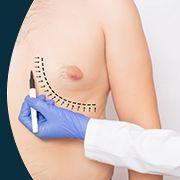A Comprehensive Approach to Gynecomastia Management
In This Article
A Comprehensive Approach to Gynecomastia Management
Indu
Updated on February 06, 2024
Medically verified by Dr. Arya
Fact checked by Dr. Pournami

Cosmetic
7 min read
You wanted pecs, but instead have man boobs? Worry not, you are not alone. And we are here to help you.
The condition you have is called gynecomastia. Curious to know how you can manage it?
Well, you’re in the right place.
This blog is to provide you with a complete guide to gynecomastia management.
Here, you can explore what gynecomastia is, its symptoms, diagnostic methods and treatment options.
Let’s dive into it.
What Is Gynecomastia?
A condition in which there is an over development or enlargement of the breast tissue in boys and men is called gynecomastia.
Their breasts become larger or grow unevenly.
While there are many reasons for gynecomastia to occur, changes in the hormonal level is the major reason. Let’s see the reasons for gynecomastia one by one.
What Are The Reasons For Gynecomastia?
-
Hormonal Imbalance: This is the number one reason for gynecomastia.
When the estrogen level in you increases in comparison to the level of testosterone, your breast tissue starts growing resulting in gynecomastia.
-
Puberty: This is the time when your hormone levels fluctuate. While your body adjusts to all the changes including hormonal changes, some boys might experience gynecomastia.
-
Ageing: When you start ageing, your testosterone levels start declining but estrogen levels remain stable or sometimes it increases.
So there is a hormonal imbalance, and the result is gynecomastia.
-
Medications: Some medicines/drugs can disrupt your hormone levels and result in gynecomastia.
These medications include anabolic steroids, anti-androgens, certain antidepressants, antibiotics, and medicines for heartburn and ulcers.
-
Health Conditions: Testes, adrenal glands, pituitary gland and thyroid are some of the hormone producing organs in your body.
If you have any health condition affecting any of these organs, there will be a disruption in hormone regulation and can be a cause for gynecomastia.
If you have liver or kidney disease, it can also lead to gynecomastia.
-
Substance Abuse: If you are someone who uses recreational drugs like marijuana, heroin, methadone or anabolic steroids, you should be beware of gynecomastia since it could disrupt your hormone levels.
Alcohol too can cause gynecomastia.
-
Obesity: When you are obese, you have excess fat tissue. This can increase your estrogen production and decrease testosterone production.
The resultant hormonal imbalance can cause gynecomastia.
-
Lifestyle: Certain food and plastics contain estrogen like compounds known as phytoestrogens. It can contribute to hormonal imbalance and thus gynecomastia.
What are the symptoms of Gynecomastia?
Looking out for the signs of Gynecomastia?
-
Breast Tissue Enlargement: This is the primary symptom of gynecomastia. Your breast tissue enlarges and there is a noticeable increase in the size of one or both of your breasts.
-
Breast Sensitivity or Tenderness: Your whole breasts or nipples will be sensitive and tender.
-
Change in the appearance of breasts: Usually a man’s chest appears flat. But when you have gynecomastia, your breasts appear swollen, firm or rubbery when you touch.
-
Nipple Changes: Nipples can appear different than normal if you have gynecomastia. It can be enlarged, protruded or retracted.
-
Uneven breasts: Sometimes, gynecomastia may affect one breast more than the other. This can result in asymmetrical breasts, ie, one breast might appear larger than the other. There would be a difference in shape too.
-
Pain or Discomfort: In some cases, gynecomastia may cause pain or discomfort in the breast tissue, particularly during physical activities or when pressure is applied to the chest area.
How To Diagnose Gynecomastia?
How do you ensure that the condition you have is gynecomastia? Don’t worry, your doctor can do it for you.
By evaluating your medical history, physical examination and after some additional diagnostic tests, a doctor can identify the underlying cause for gynecomastia and determine the most appropriate treatment.
Following are some of the diagnostic methods for gynecomastia:
- Medical History
It begins with thoroughly reviewing your medical history.
Doctor will inquire about your symptoms, the duration of breast enlargement, medications including prescription drugs, over the counter medicines and supplements you take, your previous medical conditions, family medical history, and your lifestyle that could cause gynecomastia.
- Physical Examination
This is to assess the extent to which your breast tissue is enlarged. Physical examination also helps with checking for the symmetry of your breasts or any other abnormalities in your chest area.
Doctor will also palpate your breast tissue to determine its consistency. It will also help to assess whether there is tenderness or sensitivity.
Your nipples and areolas will also be checked for any change in its size, shape or texture.
- Hormonal and Blood Tests
You already know that hormonal imbalances can result in gynecomastia. An elevated oestrogen level or a decreased testosterone to oestrogen level means that there is hormonal imbalance, which could cause gynecomastia.
Blood tests will help to measure your hormone levels including testosterone, estrogen, luteinizing hormone(LH), follicle-stimulating hormone(FSH) and prolactin.
- Imaging studies
Ultrasound and Mammography are some of the imaging studies through which your breast tissue can be evaluated. This helps in ruling out breast cancer and other serious conditions.
Ultrasound scanning will give you the composition of your breast tissue. It will help you distinguish glandular tissue and fat. It can also help you identify any abnormalities or masses in your breast.
Mammography sometimes is used in older men to test for breast cancer and to evaluate the density of breast tissue.
- Biopsy
In some cases, if the doctor has a suspicion of breast cancer or any other serious condition, a biopsy will be performed.
Here a small amount of breast tissue is examined under a microscope to make sure that it's actually gynecomastia and rule out any possibility of other serious conditions.
- Specialised Testing
If your doctor suspects that your gynecomastia is related to any other medical conditions or medications, they will ask you to undergo specialised testing.
Sometimes, you will be asked to consult a specialist to seek the necessary treatment.
 9 min read
9 min readThe Advantages of Choosing Mykare Health for Gynecomastia Surgery
 6 min read
6 min readIdentifying The Ideal Age For Gynecomastia Surgery
 6 min read
6 min readPre and Post Gynecomastia Surgery: Essential Things to Know
Get a Callback Now
What Are The Treatment Options For Gynecomastia?
Sometimes gynecomastia resolves itself without any intervention. Sometimes it may require medical treatment or surgery.
Treatment for gynecomastia depends on your condition - ie, the underlying cause, severity of breast enlargement, and your personal preference
Following table will give you various treatment options :
| Treatment Options | Description |
|---|---|
| Observation and Lifestyle Modifications | 1. Keeping track of any changes in breast size and related symptoms. 2. Engaging in regular exercise and maintain a balanced diet for overall well-being and to reduce excess body fat. 3. Avoid recreational drug use, excessive alcohol consumption, and medications that may cause gynecomastia. |
| Medications | 1. Selective estrogen Receptor Modulators (SERMs): Tamoxifen and raloxifene will help block estrogen receptors in breast tissue and reduce the effects of estrogen and thus decrease breast enlargement. 2. Aromatase Inhibitors: Anastrozole and letrozole are drugs that will suppress the enzyme aromatase, reduce estrogen levels and alleviate gynecomastia symptoms. 3. You should discuss the potential benefits and risks with your doctor, since they might have side effects |
| Surgical Intervention | 1. Liposuction - A minimally invasive surgical procedure that involves suctioning out excess fat tissue from the breast area. If you have fatty gynecomastia without significant glandular tissue enlargement, it is ideal for you. 2. Mastectomy (Excision of Breast Tissue): A surgical procedure that removes glandular breast tissue to reduce breast size and improve chest contour. If you have glandular or fibrous gynecomastia, or if you are not satisfied with the result of liposuction, you can go for it. 3. Combined Techniques: In some cases, a combination of liposuction and mastectomy may be used for optimal results, particularly in individuals with a combination of fatty and glandular tissue enlargement. |
-
Gynecomastia could give you self esteem issues and could affect your mental health. Address it - seek support groups, therapy, and communicate with your doctor.
-
If you undergo any kind of treatment for gynecomastia, keep up with all the scheduled visits to your doctor and address any concerns.
-
If you underwent surgery follow every single instruction your doctor has given and if you have any concern, consult with your doctor.
Read More About Gynecomastia Treatment
Gynecomastia is the enlargement of breast tissue in boys and men, often caused by hormonal imbalances, medications, health conditions, or lifestyle factors.
Symptoms of gynecomastia include breast tissue enlargement, breast sensitivity, changes in breast appearance and nipples, asymmetry, and pain or discomfort.
Diagnosis involves a comprehensive evaluation of medical history, physical examination, hormonal and blood tests, imaging studies, and, in some cases, biopsy.
Treatment options for gynecomastia range from observation and lifestyle modifications to medications and surgical intervention.
Observation and lifestyle modifications may include monitoring changes in breast size, maintaining a healthy lifestyle, and avoiding recreational drug use and certain medications.
Some medications can help reduce breast enlargement by blocking oestrogen receptors or suppressing oestrogen production.
Surgical interventions such as liposuction and mastectomy may be necessary for severe or persistent gynecomastia to remove excess fat or glandular tissue from the breasts.
Seek Psychological support and counselling if you experience emotional distress or self-esteem issues because of gynecomastia.
Scheduled visits to your doctor are important for monitoring progress, addressing concerns, and adjusting treatment plans as needed.
Sticking to post-operative instructions and seeking medical attention if there are any concerns are important for gynecomastia management and recovery.
Source Links
medicalnewstoday



